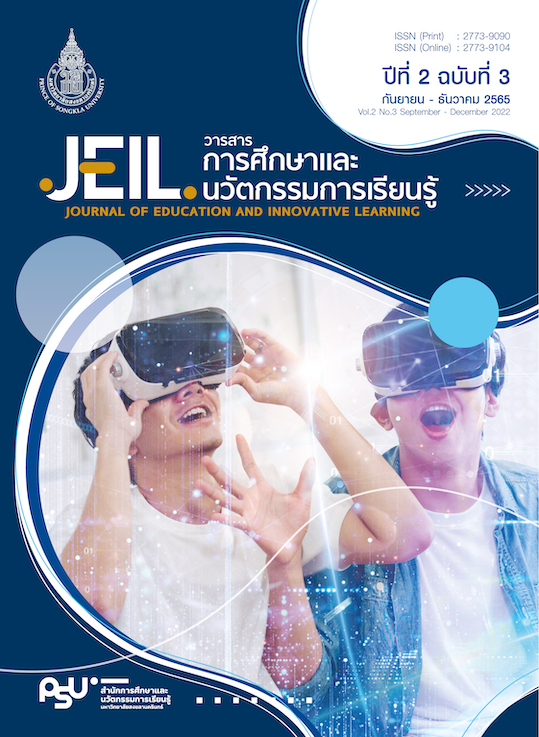ผลการจัดการเรียนการสอนเชิงบูรณาการกับการทำงานและการบูรณาการแบบสหวิทยาการในรายวิชาการตลาดดิจิทัลและเทคโนโลยีร่วมสมัย
Main Article Content
บทคัดย่อ
การพัฒนาผู้เรียนในระดับอุดมศึกษาให้มีทักษะ ความรู้ และคุณภาพที่สอดคล้องกับความต้องการของตลาดแรงงานเป็นพันธกิจสำคัญที่ทุกสถาบันการศึกษาต่างให้ความสำคัญ เพื่อการพัฒนาศักยภาพทุนมนุษย์ที่ตอบโจทย์ความต้องการของตลาดแรงงาน ดังนั้น งานวิจัยนี้มีวัตถุประสงค์ 1) เพื่อพัฒนากระบวนการจัดการเรียนการสอน ด้วยการจัดการเรียนการสอนเชิงบูรณาการกับการทำงานและการบูรณาการแบบสหวิทยาการ 2) เพื่อศึกษาผลการจัดการเรียนการสอนเชิงบูรณาการกับการทำงานและการบูรณาการแบบสหวิทยาการต่อการพัฒนาสมรรถนะของนักศึกษา และ 3) เพื่อศึกษาความพึงพอใจของนักศึกษาต่อการจัดการเรียนการสอนเชิงบูรณาการกับการทำงาน และการบูรณาการแบบสหวิทยาการ โดยใช้การวิจัยเชิงปฏิบัติการในการดำเนินการวิจัย และใช้การเรียนรู้จากประสบการณ์เป็นเครื่องมือในการจัดการเรียนรู้ของผู้เรียน ใช้การวิจัยแบบผสานวิธีโดยเก็บข้อมูลจากการสัมภาษณ์แบบกึ่งโครงสร้างและแบบสอบถาม วิเคราะห์ข้อมูลเชิงคุณภาพด้วยการวิเคราะห์เนื้อหา และวิเคราะห์ข้อมูลเชิงปริมาณด้วยค่าเฉลี่ยและค่าเบี่ยงเบนมาตรฐาน ผลการวิจัยพบว่า การจัดการเรียนการสอนด้วยวิธีการดังกล่าวช่วยเสริมสร้างสมรรถนะให้กับผู้เรียนทั้งด้านความรู้ ทักษะด้านการตลาดดิจิทัล และทักษะในการทำงานได้อย่างมีประสิทธิภาพ จากผลการวิจัยแสดงให้เห็นว่าการจัดการเรียนการสอนเชิงบูรณาการกับการทำงาน และการบูรณาการแบบสหวิทยาการผ่านการเรียนรู้เชิงประสบการณ์ เป็นวิธีการที่เหมาะสมในการนำมาใช้จัดการเรียนการสอนเพื่อพัฒนาสมรรถนะของผู้เรียนในรายวิชาชีพของหลักสูตรซึ่งมุ่งเน้นให้ผู้เรียนเกิดการเรียนรู้จากประสบการณ์ตรงของตนเองผ่านการฝึกปฏิบัติในสภาพแวดล้อมจริง
Article Details

อนุญาตภายใต้เงื่อนไข Creative Commons Attribution-NonCommercial-NoDerivatives 4.0 International License.
เนื้อหาและข้อมูลในบทความที่ตีพิมพ์ในวารสารการศึกษาและนวัตกรรมการเรียนรู้ ถือเป็นข้อคิดเห็นและความรับผิดชอบของผู้เขียน ซึ่งกองบรรณาธิการวารสาร ไม่จำเป็นต้องเห็นด้วยหรือร่วมรับผิดชอบใด ๆ และไม่สงวนสิทธิ์การคัดลอกบทความเพื่อใช้ประโยชน์ทางวิชาการ แต่ให้อ้างอิงข้อมูลแสดงที่มาของบทความทุกครั้งที่นำไปใช้ประโยชน์
เอกสารอ้างอิง
Anderson, L. W., Krathwohl, D. R., Airasian, P. W., Cruikshank, K. A., Mayer, R. E., & Pintrich, P., … Wittrock, M. C. (2001). A taxonomy for learning, teaching and assessing: a revision of Bloom’s taxonomy of educational objectives. New York: Pearson, Allyn & Bacon.
Bloom, B. S., Engelhart, M. D., Furst, E. J., Hill, W. H., & Krathwohl, D. R. (1956). Handbook I: cognitive domain. New York: David McKay.
Chaiyasain, C. (2017). Development of work integrated learning together with a new teaching innovation: a case study of the food and beverage business operations and management course of the faculty of hospitality and tourism, prince of songkla university Phuket campus. Panyapiwat Journal, 9(3), 266-276. [in Thai]
Halawi, L. A., McCarthy, R. V., & Pires, S. (2009). An evaluation of e-learning on the basis of Bloom's taxonomy: An exploratory study. Journal of Education for Business, 84(6), 374-380. doi:10.3200/JOEB.84.6.374-380
Kastberg, S. E. (2003). Using Bloom's taxonomy as a framework for classroom assessment. The mathematics teacher, 96(6), 402-405. doi:10.5951/MT.96.6.0402
Kolb, D. A. (1984). Experiential learning: Experience as the source of learning and development. Englewood NJ: Prentice Hall.
Kramer, M., & Usher, A. (2011). Work-integrated learning and career-ready students: examining the evidence. Toronto: Higher Education Strategy Associates.
Learthirunsap, S., Chiuphae, P., & Sriphanason, S. (2021). The study of integrated interdisciplinary learning management of primary 5 students demonstration school Suan Sunandha Rajabhat University. Journal of Roi Kaensarn Academi, 6(12), 101-109. [in Thai]
Ministry of Education. (2007). Learning integration to multiple intelligences. Bangkok: The agricultural Co-operative Federation of Thailand. [in Thai]
Ministry of Education. (2001). The basic education curriculum B.E. 2544. Bangkok: The Printing House of the Teachers' Council (Ladprao). [in Thai]
Musikthong, J., Puwarawuttipanit, W., & Udomphanthurak, J. (2017). Learning experiences from clinical practice in medical units and perceived self-development of nursing students in a Bachelor of Nursing Program. Nursing Journal of the Ministry of Public Health, 27(2), 181-197. [in Thai]
National Statistical Office. (2021). The labor force survey whole kingdom quarter 3: July-September 2021. Retrieved from http://www.nso.go.th/sites/2014/DocLib13/ด้านสังคม/สาขาแรงงาน/ภาวะการทำงานของประชากร/2564/full_report_q3_64.pdf [in Thai]
Office of the Education Council. (2009). The development of work-integrated learning approaches. Retrieved from http://backoffice.onec.go.th/uploads/Book/1025-file.pdf [in Thai]
Office of the National Education Commission. (2003). National Education Act B.E. 2542 (1999) and Amendments (Second National Education Act. B.E. 2545 (2002). Retrieved from http://www.bic.moe.go.th/images/stories/5Porobor._2542pdf.pdf [in Thai]
Pattaragorranan, N. (2017). The concept of the creative learning activities, learning from experience. Journal of Education Silpakorn University 15(1), 6-17. [in Thai]
Podhisita, C. (2019). Science and art of qualitative research (2nd ed.). Bangkok: Amarin Printing and Publishing. [in Thai]
Ponkhum, D. (2016). Reducing the time for knowledge acquisition: Experiential learning compared to conventional learning. The SDU Research Journal 12(3), 1-17. [in Thai]
Prasarn, O., & Kunmaneelert, N. (2021). Development of learning management competencies for undergraduate students of education program through experiential learning. An Online Journal of Education, 16(1), 1-15. [in Thai]
Ritcharoon, P., Thaneerat, A., Klaichun, P., & Putinart, C. (2016). Desirable traits study of Panyapiwat institute of management's student by using work-based learning pedagogy in convenience stores. Panyapiwat Journal 8(1), 200-212. [in Thai]
Saksittanupab, P. (2017). A model of experiential learning activity of Sisaket Rajabhat University students: A case study of foundation of english 1 subject for social studies major. Journal of Human and Society, Sisaket Rajabhat University, 1(1), 77-92. [in Thai]
Sawasdichot, D., Intharakasem, S., & Sinthusiri, P. (2015). The effect of an integrating academic services and learning activities program on the learning achievement and satisfaction of nursing students at Boromarajonani College of Nursing, Nakhon Phanom. Nursing Journal of the Ministry of Public Health, 24(3), 51-65. [in Thai]
Seaupoomee, N., & Petchkong, J. (2021). Effectiveness of experiential learning management on family and community nursing I for nursing student. Region 4-5 Medical Journal, 40(1), 81-92. [in Thai]
Taneerat, W. (2021). Effectiveness of work-integrated learning model: Case study on project formulation and policy analysis course. Journal of Education and Innovative Learning, 1(2), 141-156 [in Thai]
Udom, P. (2005). Integrated instruction, Thaksin University Journal, 8(2), 66-75. [in Thai]
Upper Southern Cooperative Education Network. (2018). Work integrated education manual. Retrieved from http://www.southcoopnet.psu.ac.th/attachments/article/69/wil-manual.pdf [in Thai]
Wichadee, S. (2011). Learners’ learning styles: The perspectives from the theory of experiential learning. Executive Journal, 31(1), 175-180. [in Thai]
Yawai, A., Vongchavalitkul, N., & Chotipurk, A. (2018). The establishment of work integrated learning system of the twelfth grade students. Sikkha Journal of Education. 5(1). 16-33. [in Thai]
Zorluoglu, S. L., & Güven, Ç. (2020). Analysis of 5th grade science learning outcomes and exam questions according to revised bloom taxonomy. Journal of Educational Issues, 6(1), 58-69. doi:10.5296/jei.v6i1.16197


